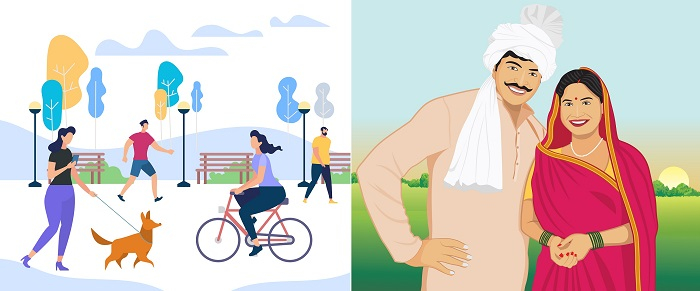

This makes it obvious that people living in cities or advanced urban areas have greater degrees of exposure to the new fashion and other related developments; in addition to this, they can easily access the newly launched products. On the contrary, people, who are living in villages or rural areas, have less information about the newly designed product. Second, their income is not in line with the cost of the most recently designed garments.

Because of such reasons, urban dwellers’ dresses are more formal and contemporary such as salwars, slacks (etc. for females), and shirts, pants, jeans (etc. for males). On the other hand, in villages, people dress in more conventional attire, such as gagahra, dothis, and pheran. Importantly, because of rural life-style, people in villages always opt for comfortable clothes rather than fashionable clothes.
In India, about two third people still reside in rural areas. One can definitely imagine the difference between rural and urban locations when travelling the breadth and length of this planet. Urban and rural areas are very different from one another. The standard of living between rural and urban India is one of the most obvious contrasts. Urban residents have better living conditions than those who reside in rural areas. Compared to urban regions, rural settings are less open and modern. Rural residents in their regions are not as compassionate as urban residents. The way people live, dress, eat, behave, and engage in other aspects of daily life, are all very basic. However, everything is easily accessible in urban areas, but it’s extremely intricate.
Why are people in villages less concious about fashion then urban people? | Lack of knowledge about fashion trends |
| Trendy style and dresses are not accessible and very expensive | |
| More drawn to cultural and religious beliefs | |
| Like to wear comfortable clothes | |
| Believes in simple living |
In rural areas, there are two distinct components to dressing: one is cultural, and the other is casual. Where each individual has their own definition of comfort. Modern clothing that incorporates Western culture is widespread nowadays. However, rural residents are likely more devoted to their customs and beliefs. Typically, we observe that society is not relocating to rural areas. And the reason for this is, rural people love to be traditional.
Rural residents are more in touch with nature, due to their roots in agriculture, they have developed more natural fabrics like khadi, cotton, and silk. Cotton and khadi are heavily used by rural people to make their apparel. In the villages, people dress in a variety of styles on a regular basis. The diversity and depth of the region’s cultures are reflected in the costumes, one of the most significant components of village life. In the villages, men typically dress lungis, dhotis, kurtas, etc. The majority of the ladies, however, dress in saris. In daily life, there are no particular dresses. Therefore, people from rural areas typically follow their traditions. It can be said that they have their own fashion.
The majority of conduct is governed by folkways and mores in rural communities, where custom is king. In village life, the sense of collective responsibility that tends to evaporate as cities grow predominates. They adhere to conventional conventions. They prefer to dress comfortably and in attire that is acceptable in society. It doesn’t matter to them what they wear or don’t wear. They have been following tradition and culture for decades. They don’t tend to change over time. Apart from all these reasons, lack of knowledge of the outside world can also be considered a cause for rural people not being stylish or fashionable.
However, being from a rural or urban area doesn’t make you fashionable. What makes you stylish is your sense of fashion and exposure to ongoing trends.
In conclusion, many different factors influence how people dress in urban areas. Some people in rural areas want to be fashionable, but their lack of fashion knowledge and judgmental thinking prevent them from doing so. However, rural people can design and produce their own fashion trends. It is not a problem to accept western culture, but one should be extremely cautious about whether their choice is good or bad in light of contemporary social norms. In summary, it can be said that rural residents dress according to their particular culture. They are not unconcerned about their appearance, but they prefer to conform to the norms that surround them.
Q1. Are People Who Live in Villages Less Conscious of Style Than People Who Live in Rich and Urban Areas?
Ans. It is true that people in rural areas are less conscious of style than people in rich and urban areas because they have different traditional ways of living, working natures, and occupations and have less connectivity with urban people.
Q2. What is the major difference between rural and urban lifestyles?
Ans. In comparison to the rural regions, life in urban areas is swift and complicated. Secondly, because of the fast pace of life in urban areas, people prefer everything ready-made, which can be used instantly. On the other hand, rural people are relaxed and prefer to prepare before using. They would rather cook and then eat; they would rather wear comfortable and loose clothing than a tight dress.